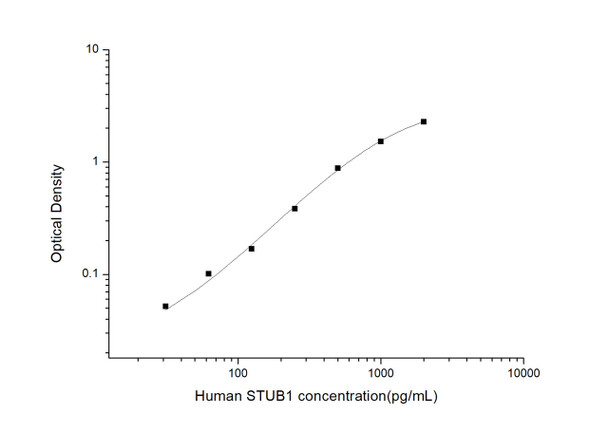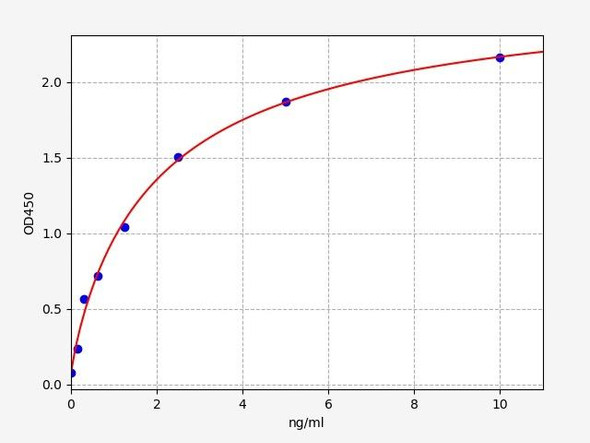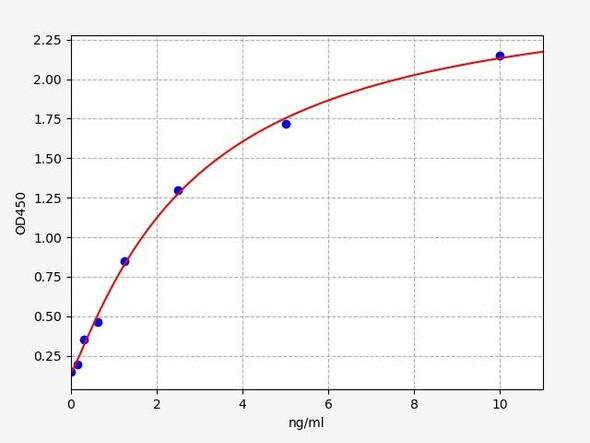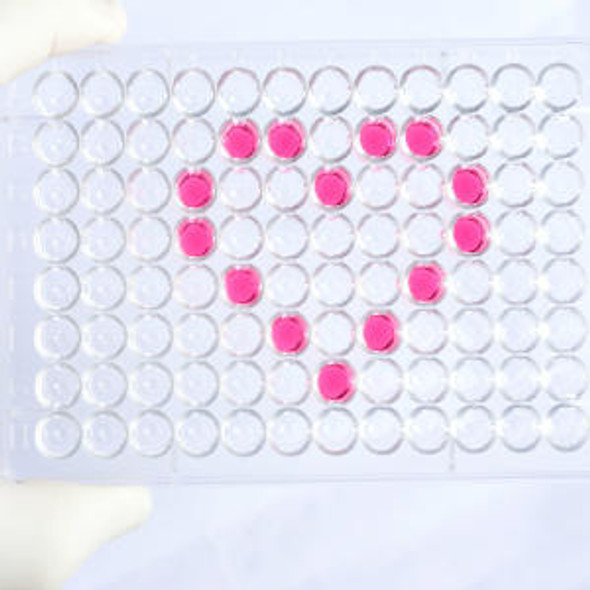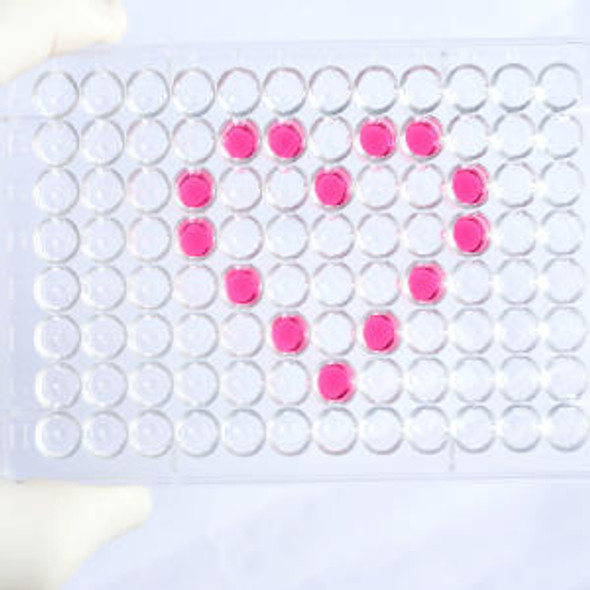Human Epigenetics and Nuclear Signaling ELISA Kits
Human STUB1 (E3 ubiquitin-protein ligase CHIP) ELISA Kit (HUES03512)
- SKU:
- HUES03512
- Product Type:
- ELISA Kit
- Size:
- 96 Assays
- Uniprot:
- Q9UNE7
- Sensitivity:
- 18.75pg/mL
- Range:
- 31.25-2000pg/mL
- ELISA Type:
- Sandwich
- Reactivity:
- Human
- Sample Type:
- Serum, plasma and other biological fluids
- Research Area:
- Epigenetics and Nuclear Signaling
Description
| Assay type: | Sandwich |
| Format: | 96T |
| Assay time: | 4.5h |
| Reactivity: | Human |
| Detection Method: | Colormetric |
| Detection Range: | 31.25-2000 pg/mL |
| Sensitivity: | 18.75 pg/mL |
| Sample Volume Required Per Well: | 100µL |
| Sample Type: | Serum, plasma and other biological fluids |
| Specificity: | This kit recognizes Human STUB1 in samples. No significant cross-reactivity or interference between Human STUB1 and analogues was observed. |
This ELISA kit uses Sandwich-ELISA as the method. The micro ELISA plate provided in this kit has been pre-coated with an antibody specific to Human STUB1. Standards or samples are added to the appropriate micro ELISA plate wells and combined with the specific antibody. Then a biotinylated detection antibody specific for Human STUB1 and Avidin-Horseradish Peroxidase (HRP) conjugate are added to each micro plate well successively and incubated. Free components are washed away. The substrate solution is added to each well. Only those wells that contain Human STUB1, biotinylated detection antibody and Avidin-HRP conjugate will appear blue in color. The enzyme-substrate reaction is terminated by adding Stop Solution and the color turns yellow. The optical density (OD) is measured spectrophotometrically at a wavelength of 450 nm ± 2 nm. The OD value is proportional to the concentration of Human STUB1. The concentration of Human STUB1 in samples can be calculated by comparing the OD of the samples to the standard curve.
| UniProt Protein Function: | CHIP: E3 ubiquitin-protein ligase which targets misfolded chaperone substrates towards proteasomal degradation. Collaborates with ATXN3 in the degradation of misfolded chaperone substrates: ATXN3 restricting the length of ubiquitin chain attached to STUB1/CHIP substrates and preventing further chain extension. Ubiquitinates NOS1 in concert with Hsp70 and Hsp40. Modulates the activity of several chaperone complexes, including Hsp70, Hsc70 and Hsp90. Mediates transfer of non-canonical short ubiquitin chains to HSPA8 that have no effect on HSPA8 degradation. Mediates polyubiquitination of DNA polymerase beta (POLB) at 'Lys-41', 'Lys-61' and 'Lys-81', thereby playing a role in base-excision repair: catalyzes polyubiquitination by amplifying the HUWE1/ARF- BP1-dependent monoubiquitination and leading to POLB-degradation by the proteasome. Mediates polyubiquitination of CYP3A4. Ubiquitinates EPHA2 and may regulate the receptor stability and activity through proteasomal degradation. Homodimer. Interacts with BAG2, and with the E2 ubiquitin conjugating enzymes UBE2D1, UBE2D2 and UBE2D3. Interacts with the C-terminal domains of HSPA8 and HSPA1A. Detected in a ternary complex containing STUB1, HSPA1A and HSPBP1. Interacts with MKKS. Interacts with DYX1C1 and POLB. Interacts (via TPR repeats) with HSP90AA1. Interacts (when monoubiquitinated) with ATXN3. Interacts with UBE2W. Interacts (via the U-box domain) with the UBE2V2- UBE2N heterodimer; the complex has a specific 'Lys-63'-linked polyubiquitination activity. Interacts with DNAJB6. Highly expressed in skeletal muscle, heart, pancreas, brain and placenta. Detected in kidney, liver and lung. 2 isoforms of the human protein are produced by alternative splicing. |
| UniProt Protein Details: | Protein type:EC 6. 3. 2. 19; Ubiquitin ligase; EC 6. 3. 2. -; Ligase; Ubiquitin conjugating system; Adaptor/scaffold Chromosomal Location of Human Ortholog: 16p13. 3 Cellular Component: nucleoplasm; intermediate filament cytoskeleton; endoplasmic reticulum; ubiquitin conjugating enzyme complex; cytoplasm; plasma membrane; cytosol; ubiquitin ligase complex; nuclear inclusion body Molecular Function:protein binding, bridging; protein homodimerization activity; ubiquitin-protein ligase activity; misfolded protein binding; Hsp90 protein binding; Hsp70 protein binding; protein binding; enzyme binding; G-protein-coupled receptor binding; TPR domain binding; ubiquitin protein ligase binding; SMAD binding; kinase binding; ligase activity Biological Process: ubiquitin-dependent protein catabolic process; proteasomal ubiquitin-dependent protein catabolic process; protein autoubiquitination; protein polyubiquitination; unfolded protein response; protein maturation; misfolded or incompletely synthesized protein catabolic process; DNA repair; ubiquitin-dependent SMAD protein catabolic process; positive regulation of protein ubiquitination; transforming growth factor beta receptor signaling pathway; positive regulation of proteasomal ubiquitin-dependent protein catabolic process; positive regulation of ubiquitin-protein ligase activity; regulation of glucocorticoid metabolic process; negative regulation of transforming growth factor beta receptor signaling pathway; negative regulation of protein binding Disease: Spinocerebellar Ataxia, Autosomal Recessive 16 |
| NCBI Summary: | This gene encodes a protein containing tetratricopeptide repeat and a U-box that functions as a ubiquitin ligase/cochaperone. The encoded protein binds to and ubiquitinates shock cognate 71 kDa protein (Hspa8) and DNA polymerase beta (Polb), among other targets. Mutations in this gene cause spinocerebellar ataxia, autosomal recessive 16. Alternative splicing results in multiple transcript variants. There is a pseudogene for this gene on chromosome 2. [provided by RefSeq, Jun 2014] |
| UniProt Code: | Q9UNE7 |
| NCBI GenInfo Identifier: | 78099173 |
| NCBI Gene ID: | 10273 |
| NCBI Accession: | Q9UNE7. 2 |
| UniProt Related Accession: | Q9UNE7 |
| Molecular Weight: | |
| NCBI Full Name: | E3 ubiquitin-protein ligase CHIP |
| NCBI Synonym Full Names: | STIP1 homology and U-box containing protein 1 |
| NCBI Official Symbol: | STUB1 |
| NCBI Official Synonym Symbols: | CHIP; SCA48; UBOX1; SCAR16; HSPABP2; NY-CO-7; SDCCAG7 |
| NCBI Protein Information: | E3 ubiquitin-protein ligase CHIP |
| UniProt Protein Name: | E3 ubiquitin-protein ligase CHIP |
| UniProt Synonym Protein Names: | Antigen NY-CO-7; CLL-associated antigen KW-8; Carboxy terminus of Hsp70-interacting protein; STIP1 homology and U box-containing protein 1 |
| Protein Family: | Chitoporin |
| UniProt Gene Name: | STUB1 |
| UniProt Entry Name: | CHIP_HUMAN |
As the OD values of the standard curve may vary according to the conditions of the actual assay performance (e. g. operator, pipetting technique, washing technique or temperature effects), the operator should establish a standard curve for each test. Typical standard curve and data is provided below for reference only.
| Concentration (pg/mL) | O.D | Average | Corrected |
| 2000 | 2.334 2.358 | 2.346 | 2.284 |
| 1000 | 1.566 1.596 | 1.581 | 1.519 |
| 500 | 0.959 0.927 | 0.943 | 0.881 |
| 250 | 0.434 0.458 | 0.446 | 0.384 |
| 125 | 0.239 0.223 | 0.231 | 0.169 |
| 62.5 | 0.178 0.148 | 0.163 | 0.101 |
| 31.25 | 0.11 0.118 | 0.114 | 0.052 |
| 0 | 0.056 0.068 | 0.062 | -- |
Precision
Intra-assay Precision (Precision within an assay): 3 samples with low, mid range and high level HumanSTUB1 were tested 20 times on one plate, respectively.
Inter-assay Precision (Precision between assays): 3 samples with low, mid range and high level HumanSTUB1 were tested on 3 different plates, 20 replicates in each plate.
| Intra-assay Precision | Inter-assay Precision | |||||
| Sample | 1 | 2 | 3 | 1 | 2 | 3 |
| n | 20 | 20 | 20 | 20 | 20 | 20 |
| Mean (pg/mL) | 94.62 | 307.91 | 875.56 | 102.66 | 293.71 | 958.48 |
| Standard deviation | 6.34 | 12.69 | 33.36 | 5.40 | 15.10 | 52.43 |
| C V (%) | 6.70 | 4.12 | 3.81 | 5.26 | 5.14 | 5.47 |
Recovery
The recovery of HumanSTUB1 spiked at three different levels in samples throughout the range of the assay was evaluated in various matrices.
| Sample Type | Range (%) | Average Recovery (%) |
| Serum (n=5) | 92-108 | 98 |
| EDTA plasma (n=5) | 92-106 | 99 |
| Cell culture media (n=5) | 91-104 | 97 |
Linearity
Samples were spiked with high concentrations of HumanSTUB1 and diluted with Reference Standard & Sample Diluent to produce samples with values within the range of the assay.
| Serum (n=5) | EDTA plasma (n=5) | Cell culture media (n=5) | ||
| 1:2 | Range (%) | 93-105 | 89-105 | 98-115 |
| Average (%) | 100 | 96 | 105 | |
| 1:4 | Range (%) | 93-106 | 87-98 | 84-95 |
| Average (%) | 98 | 92 | 90 | |
| 1:8 | Range (%) | 87-101 | 81-95 | 86-99 |
| Average (%) | 94 | 87 | 93 | |
| 1:16 | Range (%) | 86-100 | 85-96 | 83-96 |
| Average (%) | 93 | 90 | 89 |
An unopened kit can be stored at 4°C for 1 month. If the kit is not used within 1 month, store the items separately according to the following conditions once the kit is received.
| Item | Specifications | Storage |
| Micro ELISA Plate(Dismountable) | 8 wells ×12 strips | -20°C, 6 months |
| Reference Standard | 2 vials | |
| Concentrated Biotinylated Detection Ab (100×) | 1 vial, 120 µL | |
| Concentrated HRP Conjugate (100×) | 1 vial, 120 µL | -20°C(shading light), 6 months |
| Reference Standard & Sample Diluent | 1 vial, 20 mL | 4°C, 6 months |
| Biotinylated Detection Ab Diluent | 1 vial, 14 mL | |
| HRP Conjugate Diluent | 1 vial, 14 mL | |
| Concentrated Wash Buffer (25×) | 1 vial, 30 mL | |
| Substrate Reagent | 1 vial, 10 mL | 4°C(shading light) |
| Stop Solution | 1 vial, 10 mL | 4°C |
| Plate Sealer | 5 pieces | |
| Product Description | 1 copy | |
| Certificate of Analysis | 1 copy |
- Set standard, test sample and control (zero) wells on the pre-coated plate and record theirpositions. It is recommended to measure each standard and sample in duplicate. Note: addall solutions to the bottom of the plate wells while avoiding contact with the well walls. Ensuresolutions do not foam when adding to the wells.
- Aliquot 100µl of standard solutions into the standard wells.
- Add 100µl of Sample / Standard dilution buffer into the control (zero) well.
- Add 100µl of properly diluted sample (serum, plasma, tissue homogenates and otherbiological fluids) into test sample wells.
- Cover the plate with the sealer provided in the kit and incubate for 90 min at 37°C.
- Aspirate the liquid from each well, do not wash. Immediately add 100µL of BiotinylatedDetection Ab working solution to each well. Cover the plate with a plate seal and gently mix. Incubate for 1 hour at 37°C.
- Aspirate or decant the solution from the plate and add 350µL of wash buffer to each welland incubate for 1-2 minutes at room temperature. Aspirate the solution from each well andclap the plate on absorbent filter paper to dry. Repeat this process 3 times. Note: a microplatewasher can be used in this step and other wash steps.
- Add 100µL of HRP Conjugate working solution to each well. Cover with a plate seal andincubate for 30 min at 37°C.
- Aspirate or decant the solution from each well. Repeat the wash process for five times asconducted in step 7.
- Add 90µL of Substrate Reagent to each well. Cover with a new plate seal and incubate forapproximately 15 min at 37°C. Protect the plate from light. Note: the reaction time can beshortened or extended according to the actual color change, but not by more than 30min.
- Add 50 µL of Stop Solution to each well. Note: Adding the stop solution should be done inthe same order as the substrate solution.
- Determine the optical density (OD value) of each well immediately with a microplate readerset at 450 nm.

